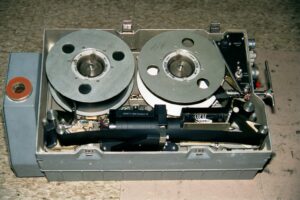Very little there’s known about the ELINT system on the SR71. It was finally declassified in the 1980s after being on the SR71 since 1964. This is an attempt to explain the system and its capabilities. It came in 2 versions; the early version was known as the EMR (Electro Magnetic Recorder) and later as the EIP (Elint Improvement Program). The system would detect, Identify and locate RADAR signals from both sides of the aircraft out to the horizon. My time on the SR71 program from 1964 until 1992 was as a Tech Rep for AIL (Airborne Instrument Laboratories); programming, analyzing, and training Air Force ELINT Intel analysts.
Sometime in 1964 AIL was selected to build the EMR, ground check out system and processing software for the SR71 Blackbird. The Frequency. range was from 60Mhz to 16Ghz for RADARs and lower frequencies in the Khz region that cover COMMS (communication signals). The antenna array for radar signals was arrays of spiral antennas in azimuth and elevation configurations covering octave bandwidths. The COMMS antenna was a ‘towel bar’ configuration. The DF (Direction Finding) of Radar signals was only amplitude comparison; there was no DF for COMMS. RADAR signal detection capability was excellent; however DF capability was marginal because of the location of the system on the aircraft and the shallow look angle to the horizon.
The Airborne recording and ground playback system was built by Parsons Electronics. The Fidelity of the system to record microsecond pulses was achieved using very fast-moving tape over a fixed record/playback head. ELINT analysts used an early model of an adage interactive graphics computer console to process the data to a reportable format. All the data programs were written in FORTRAN on Hollerith punch cards. Processing of the ELINT data was delayed until the navigational data from the ANS (Astro Navigation System) was available.
Sometime in the 1970s, the Air Force decided to reconfigure the sensor load on the SR71. The location of the ELINT system on each side was moved to a smaller sensor bay requiring a complete rebuild of the ELINT collection system. During this same time the CDC (Control Data Corporation 3200) computers that processed pre and pro flight data were replaced by SEL (Systems Electronics Lab) computers.
AIL built the EIP along with new processing software to replace the EMR on the SR71. The Frequency. range was from 60Mhz to 16Ghz for emissions of ground-based RADARs. Dual arrays of spiral antennas in azimuth and elevation, covering octave bandwidths, were used. COMMs detection require some loitering time; the speed and altitude of the SR 71 prohibited that. That capability was not included in the EIP. The DF (Direction Finding) for the Radar signals was Phase Comparison in both azimuth and elevation, based on the Chinese Remainder Theorem algorithm. RADAR signal detection and DF capability was excellent.
The EIP was configured to accommodate real time operation.The Airborne recording and ground playback unit was an RCA video record/playback unit. Fidelity was maintained by
 a fast-moving, rotating record/playback head, over a relative slow-moving tape. Navigation data from the ANS system was also recorded. Tape was rewound and data played back and digitized in a Pre formatter also built by AIL. For processing, ELINT analysts used the new computers to process the data to a reportable format. The long-term goal was to collect data from a target area, and during a refueling, playback the data to a compatible ground processing system on the tanker, process and transmit, information back to a ground site.
a fast-moving, rotating record/playback head, over a relative slow-moving tape. Navigation data from the ANS system was also recorded. Tape was rewound and data played back and digitized in a Pre formatter also built by AIL. For processing, ELINT analysts used the new computers to process the data to a reportable format. The long-term goal was to collect data from a target area, and during a refueling, playback the data to a compatible ground processing system on the tanker, process and transmit, information back to a ground site.
